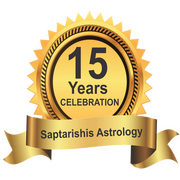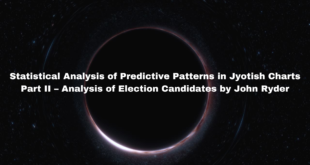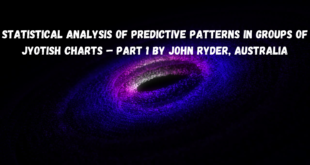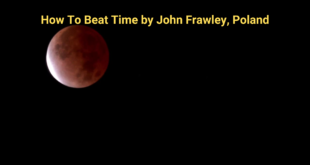Related Articles
The first sanskrit verse of Brihad Jataka is benedictory. It is the verse of obeisance too to the Sun God.
In the second verse, Varaha Mihira enunclates that his exposition of Hora Sastra in a nutshell slides on through the verses of various prosodi metres, with inward multiple meanings. The solemn declaration enjoins any reader to go back again to the benedictory verse and seek the inward purposive of the author. Let me first transliterate it into English for ready reference to precede my write-up o f its inwardness.
मूर्तित्वे परिकल्पित शश भृतो
वर्तमा पुनर्जन्मनम् आत्मेयात्म विदां क्रतिश्च यजताम्
भर्तामर ज्योतिषां लोकानां प्रळयोदय स्थिथि विभुश्चानेकधा यः श्र्रितौ
वाचं नः स ददतु नैकाकितण स्त्रैलोक्य दीपो रविः
mūrtitve parikalpita śaśa bhṛto
vartamā punarjanmanam ātmeyātma vidāṁ kratiśca yajatām
bhartāmara jyotiṣāṁ lokānāṁ praḻayodaya sthithi vibhuścānekadhā yaḥ śrritau
vācaṁ naḥ sa dadatu naikākitaṇa strailokya dīpo raviḥ
N.B: For the sake of pronunciation of the words in the above verse, follow the diacritical marks given below:-
Brihat Jataka contains 385 verses. To hint this number, Varaha employs Sardula Vikridita metre for the composition of the benedictory verse. By the katapayadi pneumonics, (Sa = 5, du = 8, la = 3) we get 385 by the reversal of above numbers of the term, Sardula. The first chapter of the book concerns the zodiacal signs. The second chapter concerns the planets.
And, as my esteemed readers know, the science of astrology is concerned with the signs and planets. The first chapter contains 20 verses and the second chapter consists of 19 verses. And Varaha exposes the subject of astrology in 380 verses in 25 chapters. See how this number strangely coincides with the product (20 x 15) of the number of verses in the first chapter and the number of verses in the second chapter. The 26th chapter contains 3 verses relevant to the contents, Then the number , goes upto 383. This number is deducible numerically from the word, ‘bahulam’ ( ba — 3, hu = 8, la = 3) in the 4th quarter of the 2nd verse. The verse in praise of the Sun at the end makes the number 384. This number is found by Varaha’s special use of the word, ‘bhadanta ‘ in the 10th verse of the 7th chapter, ‘Bha ‘ means the zodiacal signs, the number of which is 12. “Danta” means teeth, the number of which is 32. Thus we get the number 384 by the product. of 12 and 32, The last verse which has nothing to do with the subject makes the number 385, which the Sardula metre of the benedictory verse numerically reveals, as mentioned previously, That astrology is constituted with the zodiacal signs and planets may also be gleaned by Varaha’s choice of Sardula Vikridita metre for his first and benedictory verse, if we know its definition, also which is as follows:
“Suryaswair yadi maha sajah satatagaha sardala vikridilam “
Surya (the twelve suns) indicates the 12 zodiacal signs. Aswa ( the 7 horses of the Sun) indicates the 7 planets.
From the above definition, the order of the ganas of each quarter of the verse, is as follows:
Ma — Mollosus
Sa — Anapaestus
Ja — Amphibrachys
Sa — Anapaestus
Ta — Antibaceltius
Ta — Antibacchius
Guru – long syllable
The symbol – denotes a laghu (a short syllable). The symbol — denotes a guru (a long syllable). A short vowel gets one syllabic instant (matra) while a long vowel gets two syllabic instant (matras). There are 8 short vowels while there are 11 long vowels. Therefore, there are 30 syllabic instants [(8 x 1) + (11 x 2) = 30] in eah quarter of the verse. So for the four quarters of the verse, there are 120 syllabic instants or Matras.
This gives us to understand that Varaha has in mind the popular udu dasa of 120 years. We have this inference by his use of the word, ‘Sasabhrto’ in the first quarter of the verse which ends with the word, Ravi. This evidently means that the udu dasa commences from the Moon (since sasabhrito is in ablative case) closes with the Sun. We are also reminded of 10 years of the Moon’s dasa and 6 years of the Sun’s dasa, by his particular choice of the two words, Sasabhrito and Ravi for the Moon and the Sun respectively, since Sasa gives 10 (sa = 5 + sa = 5), while Ravi gives 6 (Ra=2+vi=4=6). But no nomenclature is given for the remaining planets for our discernment of their dasa years. Thus the choice of sardula metre for the first and benedictory verse, is finely cherished.
The verse begins with murtitwe and ends with, trailokyadeepo Ravihi. Murti reminds us of Trimurtis, viz., Brahma, Vishnu, Maheswara. Astrology is of three branches, viz., Siddhanta, Samhita and Hora. Trailokyadeepa means the exponent of the science of three lokas, viz., purva loka, ihaoka and parttloka. The exponent is the Sun and the science that presages our attainment of lokas is Hora sastra. Thus Varaha pays obeisance to the Sun God, with the request for his word – power to expose Hora Sastra, the one, in the triad of the astrological sciences (murtitwe). Accordingly he makes mention of Hora in the second and third verses. Varaha exactly uses 26 words in the verse and completes his treatise in 26 chapters.
The 26 words in the verse are as follows:-
1.Murtitwe, 2. Parikalpitah, 3. Sasabhrto, 4. Vartma, 5. Apuarjanmanam, 6. Atina, 7. Iti, 8. Atmavidam, 9. Kratu, 10. Cha, 11. Yajatam, 12. Bharta, 13. Amarajyotisham; 14. Lokanam, 15. Pralayoda sthite vibhuh, 16. Cha, 17. Anekadha, 18. Yah, 19. Sritau, 20. Vachani, 21. Nah, 22. Sa, 23. Dadatu, 24. Naikakiranah 25. trilokyadeepah, 26. Ravihi.
Now let us get at how the reference of lagna and the seven planets may be elicited by the phraseology used in the verse,
Murtitwe means form, body, etc. This term is a hint for lagna since it becomes Tanu (body) bhava. Sasabhrito is clear of course for the Moon. Vartma punarjanmanam means the path for those who do not have rebirth again on this earth. Here Mars is reminded because Mars is connected with earth because of his birth from earth, since `Ku’ means earth and `Ja ‘ means, one who is born, thus forming Kuja. Atma hints Mercury, because Atrna meaning the Supreme Being, Vishnu, who is knowable by Mercury in astrology. Venus is known from kratuscha yajatam, since the lord of yajurveda is Venus. In bhartamara jyotisham, the word bharta means the lord or Iswara. Among the planets it is Saturn who is given the title, Iswara, as `Saniswara.’ Thus Saturn also is inferred. And Ravi, the last word. is the Sun. Thus, lagna and the seven planets are deemed to have been mentioned in the benedictory verse. Sasabhrito vartma, hints the passage of the Moon in the lunar mansions and the word, vartma may either mean the path of theSun which we may call ecliptic or zodiac.
 Saptarishis Astrology Magazine Into Creating Astrologers
Saptarishis Astrology Magazine Into Creating Astrologers






